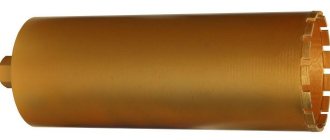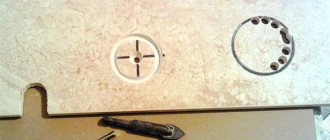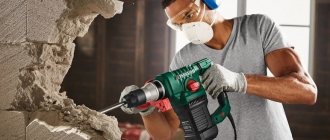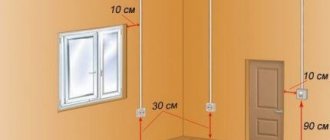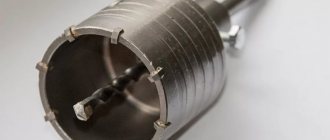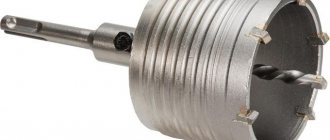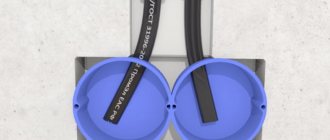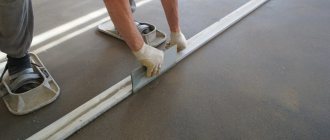The most famous areas of use
Due to its cylindrical shape, the diamond core bit is the ideal tool for drilling this type of hole pattern. The cutting tool is installed in the clamping mechanism of an electric drill or hammer drill. Without these devices it is completely useless. In addition, not any drill is suitable for tandem with a diamond bit for drilling tiles. An electric drill with a low-speed function and smooth start is required, or a hammer drill with the ability to turn off the impact mechanism and reduce the rotation speed of the chuck.
The tool should rotate the head smoothly and slowly. The drilling itself occurs solely under the influence of pressure on the operator’s tool
You also need to press very carefully on the drill or hammer drill during the process. The slightest leak in the thickness of the adhesive under the tile can lead to cracking of the elements if excessive pressure is applied during work using a tile crown
To work with red clay tiles, heads with a carbide or diamond cutting edge are used. Diamond tools are used along with KS series crowns to make holes in natural stone and porcelain stoneware. There are also heads with a metal cutting edge, but their use is limited to working with wood.
The industry produces cutting heads ranging in size from 19 to 120 mm in diameter. Diamond core bits measuring 30 mm are used to install water supply pipes and other sanitary fittings. To install an electrical outlet or switch, you must use a larger diameter socket.
Principles of working with a diamond cylinder for drilling concrete
To perform the assigned tasks with the highest quality, you must be able to work with tools and a diamond bit for concrete.
There is nothing complicated in the work, but there are certain principles that must be adhered to. Rules for working with diamond bits for concrete:
- Do not press too hard - this may impair the performance of the cylinder and reduce its service life, leading to breakdown.
- When working with reinforced concrete, it is better to use a dry cut and be sure to check the reliability and strength of the fixation. If the fixation is unreliable, the cylinder may become deformed and become damaged beyond repair.
- If diamond segments and edges are fixed with solder, then a water supply must be used during the work. If there is no cooling, the solder can noticeably weaken and even become deformed.
- The size of the installation must be correctly selected, match the assigned tasks, and guarantee the required level of efficiency and quality.
Crowns for concrete
Drilling holes in concrete for socket boxes is performed with special crowns. In addition to concrete, they can be used on brick, reinforced concrete and any stone. The large diameter of the crown is most often used when installing socket boxes or for laying pipelines through walls.
The shape of the crown is a piece of pipe with holes in the side walls to remove waste waste. Along the perimeter of one edge there are solderings made of special alloys. They serve as the cutting element of the tool. In the center on the other edge of the tube there is a through hole for screwing in the shank. It is necessary for fastening the bit in the chuck of a drill or hammer drill. The shank itself has a seat on the crown side for installing a centering drill. During operation, the drill plays a guiding role so as not to go astray from the markings.
Crown in analysis
The center drill and shank are often sold as one set with an attachment. There are also extension cords designed for rotary hammers with different cartridges: SDS Plus or SDS Max. The extensions have standard threads similar to those on the crown body, so they are easy to change. The center drill can be cylindrical or conical. The standard bit is usually supplied with a cylindrical drill bit, while the extended shank may be sold with a tapered drill bit.
The efficiency of drilling depends on what kind of soldering the crown is equipped with. The fact is that each soldering is designed for a specific material being drilled. For example, soldering on concrete will quickly fail if you use it to drill into reinforced concrete.
Carbide tipped
The most common in everyday life are crowns with soldered metal carbide alloys. The alloy is very strong and durable, but if the fittings are caught, the soldering will quickly fly out. They are better for drilling into plain concrete or brick. You can, of course, drill through reinforced concrete to the level of the reinforcement, but this level cannot always be guessed.
The carbide-tipped bit is suitable for use with an impact drill or hammer drill. The low cost of the product has made it popular in household use for installing socket boxes.
Diamond brazing
Anyone who has ever cut reinforced concrete with a grinder knows that it is better to do this with a diamond blade. Drilling through reinforced concrete involves a similar technology, only instead of a disk, a diamond-tipped crown is needed. Its design consists of segments coated with diamond coating. Diamond chips allow you to cope with any hard material, even reinforcement. But here we must remember that drilling into reinforced concrete and other materials occurs only in a non-impact method. Otherwise, the crown itself will deteriorate, plus the load-bearing elements of reinforced concrete structures will undergo unwanted destruction.
Diamond tips drill well into brick, tiles, and tiles, which allows you to make a smooth hole. However, the high cost of such crowns allows them to be used in professional construction. It is not advisable to buy an expensive nozzle to make several holes for socket boxes at home.
Diamond coating is characterized by different hardness, as evidenced by the markings of the crowns:
- Marking with the letter M indicates soft diamond coating. Such crowns are used for drilling high-strength concrete and are easily cleaned of dust contamination;
- medium-hard diamond coating marked C is suitable for drilling reinforced concrete;
- Hard-coated bits, marked with the letter T, are used for low-speed drilling of high-grade concrete.
You can view the list of diamond bits from some popular companies in the table below:
Tungsten carbide-coated brazes
A crown with such tips can be drilled not only into brick or concrete, but also into tiles. This is very convenient when you need to drill a socket for a socket box on a concrete wall trimmed with ceramic tiles. With only one tungsten carbide coated bit, the hole is drilled in one go. The main thing is to choose the right diameter.
Tungsten carbide coated bit with shank for drill
The attachment is equipped with a hexagonal shank designed to be clamped by a drill chuck. Drilling efficiency is achieved by the power of the tool, which should be more than 800 W. Although this coating is universal, it is still afraid of metal. Reinforcement caught in the wall will quickly damage the soldering joints. Therefore, on a reinforced concrete wall, tiles are first drilled with a tungsten carbide-coated nozzle. Then, take a diamond bit and continue drilling with it. Naturally, their size should be the same.
Varieties
In order to find out how to choose a set of crowns, it is worth understanding their variety.
In the photo of a set of bits you can see a section on the surface of a steel pipe. The fastening process takes place using a hammer drill chuck with grooves - clamps. They comply with the SDS standard.
There are different options for nozzles. It all depends on the purpose of use, in particular, on the material used. Criteria such as the type of fastening are also important. The diameter of the holes is important;
The following main types of crowns are made for concrete:
Tooth type crowns
The most suitable option for impact drilling will be gear-type drill bits. The material they are made of is quite durable, made of hard alloys. Shanks are suitable for attaching tool chucks.
Note! This type of crown is best used in spaces between bricks or slabs.
Diamond crowns
It is worth using diamond core bits for socket boxes for impactless drilling. This option is considered a more advanced, modern model. Therefore, nozzles are used for hammerless drilling.
In terms of external characteristics, they are smooth and have small cutouts. They are formed by the accumulation of a small dusting of diamond sand and corundum particles.
Comparing this method with the drum method, we can highlight a number of undoubted advantages:
- low dust content;
- high quality characteristics. Holes in solid material are made precisely to suit your needs;
- The tool is quite easy to work with due to low recoil;
- the material being processed is not additionally loaded with impact loads. In the latter version, cracks often appeared because of this;
- low noise level.
Even with metal reinforcement of concrete slabs, crowns cope.
Their diameter is 12-650 mm, which allows you to make a hole approximately 1.5 m deep.
Crowns standard KS
Another option is to use KS standard crowns, which have a diamond coating.
Their peculiarity is that on the cutting edge there are elements that protrude beyond the surface area. Such features are replacing gear bits made of hard alloys.
Their scope of application is huge. Here are a few of them:
- use in rocky soil;
- in slabs;
- use in monoliths.
Among the main advantages of use, a long service life is noted; repairs are not required during the process.
Description of the tool
The diamond crown looks quite typical and is attached to a special metal tail. Externally, the design resembles a drill with a small bowl. Its size corresponds to the resulting hole.
Diamond crystals are fixed on the extreme part of the cutting edge using vacuum-diffusion welding. The greater their number, the easier it is to drill. There is also a galvanic application method, which also produces a dense layer of diamond “grains”. Such a tool can be used to work with hard porcelain stoneware, but there is a risk that the attachment will not cope with the load after prolonged use and will lose part of the working layer.
Drilling technology
A hole in a ceramic tile is made as follows:
- switch the drill to non-impact mode and install a drill of the required diameter in the chuck. The hole in the tile should be made with a larger diameter than in concrete, otherwise when drilling concrete in the hammer drill mode, the tile may crack;
- if the tile is not yet glued, it is soaked for 40-50 minutes. (except porcelain stoneware);
- markings are applied. The location is selected so that the edge of the hole in relation to the edge of the tile is at a distance of at least 15 mm;
- carefully, avoiding significant effort, begin to drill.
Preliminary measures are taken to prevent the drill from slipping; the following techniques are used:
- scratch the glaze with the corner of a file or a hardened screw;
- stick paper tape (also known as crepe tape or masking tape) or electrical tape;
- mark with a clerical proofreader;
- drill through a jig - a block with a hole of the same diameter, pressed tightly to the tile.
Overheating of ceramics in the drilling zone leads to the appearance of cracks. To avoid this problem, the drill is periodically cooled. Having drilled through the tiles, install a concrete drill bit in the drill chuck.
The tiles that have not yet been installed are drilled in the same way as the glued ones - from the front side. The reason is that when the tool comes out of the material, chips often form.
Wet and dry cutting
It is believed that the most effective and acceptable method of drilling concrete with a crown is wet, which involves supplying water to the drilling zone. However, in practice this method is not always relevant. This is due to the fact that some construction activities involve work in places where water supply is not possible. For such cases, a dry drilling method is provided.
Features of the bits, depending on the drilling method:
Wet cut The essence of the method is the non-stop supply of water to the working area throughout the entire drilling process. This provides the necessary cooling to the tool and prevents overheating, which can lead to deformation and, accordingly, rendering the tool unusable. Some of the highest quality models are professional crowns from Japanese brands. An analogue of a tool that is relevant for independent use at home are Austrian and Russian brands. Dry cut
When drilling concrete with diamond core cutters using the dry method, special attention must be paid to the placement of the support column. Since even minimal displacement can lead to breakage of spray-coated elements
A prerequisite for ensuring the longevity of the tool is high-quality lubrication. Some of the most reliable and effective attachments are models from German and American manufacturers.
It is adequate operation and high-quality care of the tool that ensures its effective operation and long service life.
The bit segments have diamond inclusions, which allows the tools to be used when drilling concrete and reinforced concrete
Recommendations from professionals
In addition to general advice, it is worth familiarizing yourself with the recommendations of craftsmen and specialists in working with tiles. They indicate the mandatory presence of a diameter sign on the crown itself
Others focus on the presence of tooth set, since cheap materials may not have them at all. Such low-grade crowns will not be able to drill through a tile covering, but an inexperienced buyer will only be able to find out about this directly while cutting the tiles
Experts note that you can make a hole in a red clay tile using a diamond-coated nozzle and a carbide cutter. Also, a tool with precious coating can easily cope with porcelain stoneware, just like the attachments of the KS series.
Another recommendation is to buy crowns as a set. This way you can save money and avoid the mistake of choosing the wrong diameter. Most masters prefer sets with different types of crowns. Thanks to simple devices, ceramic, porcelain tiles, tiles and mosaic tiles get smooth edges without chips or cracks.
Varieties by characteristics
Crowns differ from each other in the following design parameters:
- Diameter;
- Length;
- Fastening method (shank design);
- Drilling technology – dry or wet.
The geometric characteristics of the hole depend on the length and diameter. Products with 3 types of fastenings (shanks) are available for sale:
- Hexagon. Securely attaches to a classic drill chuck. The diameter of the tail part is 10 mm.
- SDS-Plus. Fasteners for a classic hammer drill chuck.
- SDS-max. The design is almost the same as SDS-Plus, but with an increased diameter of 20 mm.
In industrial construction, products of the SDS-max design are more often used. Also suitable for domestic construction, provided that a hammer drill with a suitable type of chuck is used. The length of the shank affects the drilling depth.
How to drill?
Making a hole in porcelain stoneware is much easier than it might seem at first glance. There are several rules that must be followed to obtain a quality result. They will also help avoid early crown failure:
Be careful about cooling the crown during operation. The most important thing you must do is not to let the crown heat up above the permissible temperature.
Be sure to use a backing
You can use larger plywood or chipboard. This simple solution will protect materials from possible damage and provide additional safety during work.
- Start making a hole from the front side and constantly make sure that the drill goes straight into the porcelain stoneware. When the crown comes out, a small chip always forms, which is not desirable on a decorative surface.
- Using core drill bits will save you from many mistakes.
- It is recommended to drill not all the way, but 2/3 of the slab. Then all that remains is to knock out the porcelain stoneware plug.
- Do not press too hard on the drill while working, as this may cause the tiles to split. Towards the end, minimize the impact altogether.
- Carry out drilling work before installing the slab. This way you can always correct accidental errors.
Small holes are usually made for dowels. Large – suitable for mounting sockets, pipes or decorative elements. For drilling, it can be used as a drill, or as a hammer drill with the impact action turned off.
Small holes
In order to make a hole in porcelain stoneware with a diameter of up to 10 mm, get drills with a diamond tip. During operation, be sure to ensure an uninterrupted supply of fluid to the drill tip. This will allow cooling to occur and the drill will remain sharp longer.
When drilling, position the drill at a 90 degree angle. To secure this position, use holders or a special machine. At the beginning of work, you need to bring the drill already turned on to the porcelain stoneware, otherwise the drill will slip and damage the decorative layer of the tile.
Large holes
The principle of drilling large diameters does not differ from conventional work. Only here you will need diamond crowns for porcelain tiles. Also keep the drill at an even angle and do not forget about the coolant.
Drill all the way?
When working with porcelain stoneware, both through drilling and incomplete drilling are acceptable. The last option requires special attention. Make a hole 2/3 of the required depth and knock out the remaining plug with a sharp blow. You only need to strike from the front side of the tile. This creates a noticeable chip on the back of the panel.
Once you start drilling, don't stop. As the drill operates, the oil and spray heat up; if you stop, they will harden again. Such a rash decision will have a detrimental effect on both the crown and the porcelain stoneware.
Cooling
When drilling, diamond-coated bits become very hot. Because of this, the product deteriorates. With one-time use, you may not notice it in vain, but soon the defect will manifest itself.
Due to overheating, the characteristics of the drill first deteriorate, and then destruction occurs. As a result, you will be purchasing a new crown.
Cooling during work will ensure longer and better performance of the crown. To do this, use one of the methods:
- Constant water flow. For this method, you can get a tool that has a built-in water supply function. You can also be creative and supply water from outside. This is not always convenient if you are making a small hole.
- Puddle. Make a puddle at the site of the future hole. While working, add water as needed. This cooling option is easier than the previous one, but also less efficient.
Assessing all the nuances of the work, we can conclude that using diamond core bits when drilling porcelain stoneware is quite feasible at home.
You will learn even more information about diamond crowns in the next video.
Common mistakes
First of all, the foreman (worker) observes safety precautions. He uses protective clothing that does not pose a risk of tissue wrapping around the crown. And the rough surface coated with a diamond layer is capable of capturing the material from which the protective suit is made. Protective gloves, a respirator and goggles that completely and tightly cover the upper part of the face are required.
The most common mistakes when working are as follows.
- The destruction or separation of the cutting tooth occurs mainly due to dry drilling or jamming of the bit (jamming on a reinforcing rod).
- Abrasion of the nozzle in the contact area of the fragment - its sign is the changed color of the alloy. The reason is drilling without water, overheating of the bit, too fast rotation of the product at the point of work. For example, with frequent and long-term work on porcelain stoneware or steel, the crown becomes dull over time both from excessive force and from overheating.
- A fragment tilted inward is formed when trying to bypass the standard diameter of the hole, a sudden start, or lateral contact with the reinforcement.
- An element that protrudes outwards indicates a too fast start-up, more than the required number of cutting fragments, or an excess of the required drive power when the fragments are jammed.
- Cracks and breaks on the product itself indicate an unacceptable load on the crown, including lateral impacts, and horizontal runout (misalignment) of the entire product. The consequence of the latter is uneven wear of the crown, including wear of the walls of the nozzle.
- Dents on the crown indicate that the product has curved like an egg and has become oval. The reason is the crown getting stuck, strong blows to it.
Any other changes in the shape of the body are a consequence of excessive wear due to excess load.
See below for what diamond drilling of concrete looks like.
How to make a large diameter hole without crowns
It often happens that at the right time the necessary tool is not available. How then to make a hole of large diameter?
Here are some options.
Wire cutters
This is a cheap and cheerful option for working with tiles. If you need a hole near the edge of the tile, carefully use pliers to bite off small pieces of ceramic.
In this process, the main thing is to act carefully and slowly.
Tile drill
There is a special drill for tiles, which is popularly called a “feather”. It has a spear-shaped shape and a sharp edge, thanks to which it bites into the tile well and passes through the glazed layer.
- Draw a circle that needs to be drilled.
- In this circle, use a small drill to make many small holes nearby.
- Use pliers to bite off and remove excess fragments inside the circle.
- The edges of such a hole can be sanded with sandpaper to remove sharp edges and create a beautiful geometry.
Bulgarian
An angle grinder or grinder is also suitable for drilling holes in tiles.
note
The disadvantage of this method is its noise and large amount of dust. But on the other hand, the grinder allows you to make shaped cuts.
If the desired hole is near the edge, use the grinder's diamond disc to gradually scrape off the excess. Make short cuts and then remove ceramic fragments using smooth movements.
How and how to drill holes for socket boxes in concrete
It is necessary to make recesses in concrete quite often, including when performing electrical wiring. Furrows are made using wall chasers. But the places for switches and sockets are prepared in a different way.
Concrete crown - a piece of metal pipe made of tool steel
To determine the center, you first need to mark a cross on the wall using a tape measure and a pencil. Then you need to outline the intended circle, use a drill to make four holes at the intersection of the circle and straight marking lines, as well as in the center. After this, you will need a special concrete cutter, that is, a crown.
It is a piece of metal pipe, one end of which has teeth made of high-strength material, and on the second there is a flange with which the device is fixed to the rotation mechanism. The shank has a hole for attaching a centering drill, which ensures the desired direction of rotation of the crown. The drill always comes complete with a cutter. If it is necessary to make a through hole in thick walls, use an extension for a concrete crown. It significantly expands the operational capabilities of the device.
The advent of crowns greatly simplified the process of making holes. When performing work with a drill and then knocking out concrete with a chisel, not only a lot of physical effort and time is spent, but the recesses themselves turn out to be uneven.
The crown allows you to create technological holes of large and small diameters
How to apply a crown
Diamond bits are used in repair and construction work as attachments for hand-held power tools. This could be: a drill, a hammer drill.
Before using the equipment, you need to insert a centering drill into the shank. Next, the bowl itself is screwed onto the thread. The assembled bit is installed in the drill chuck.
. A unique diamond bit for dry drilling in reinforced concrete!
Watch this video on YouTube
In order for the bit to fit correctly into the plane of the working surface, you should make sure that the equipment is located at right angles to the structure that you plan to drill. This will prevent sudden jerks from the connected equipment.
Most often, such an incident occurs when working with brickwork or granite stone. This point is taken into account when using a drill. When using a hammer drill, shock absorption is achieved using a special system - a damper.
When making a hole with a diamond crown, you need to decide on the drilling method. Wet or dry drilling is used. The first option is strictly prohibited from being used without water. Due to overheating, the segments will quickly become unusable. Undocking of connections is also possible.
Diamond crowns are used in compliance with the following rules.
The effort should be applied at intervals of 2-3 seconds (minimum). A break is necessary to fill the cavities with a new portion of water, with the help of which the cutting tool is cooled. During work, attention is paid to the timely removal of sludge from cavities
If this is not done, the drill may jam. When restoring equipment, it is recommended to use laser welding. Brazing can only be used for crowns intended for drilling unreinforced concrete. It is important to consider the parameters of the crown and tool. The number of revolutions recommended for equipment should not exceed the maximum capabilities of the equipment
Otherwise, the tool will fail. When performing a large amount of work, you need to take breaks to cool the tool attachment and motor. It is unacceptable to overheat them.
Compliance with the speed limit and intervals during the drilling process ensures not only high-quality installation, but also extends the service life of the tool.
Criterias of choice
The following criteria will help you choose a suitable diamond crown.
Manufacturer
Tools made by well-known manufacturers are popular. Their products are distinguished by high productivity, durability, and long service life. When choosing crowns, experts recommend paying attention to the following brands:
- Super Hard;
- Trio Diamond;
- FIT;
- Di-Star;
- Vira;
- Strong.
Type
Equipment for making holes according to the type of design comes in the following variants.
Crown . This is a core drill or a hollow cylinder equipped with a cutting part. It is performed in the form of a ring or individual segments.
Adapter for crowns . This is a device that acts as an extension cord. It is used to connect the power tool and the crown. When choosing it, you should take into account information about the nozzle holder and the equipment providing the driving force.
Centering drill . Externally, the device bears little resemblance to a regular drill. Its purpose is to set the alignment when making holes of large diameters (using a crown). Some crowns are equipped with this item, which facilitates the installation process.
Crown diameter
This parameter corresponds to the size of the hole being made. It is measured in millimeters. Options for running diameters of equipment: 32; 35; 68; 70; 76; 82 mm.
| Diameter, mm | Application |
| 52-58 | hole for internet cable |
| 68-82 | channel for socket boxes |
| more than 82 | technical holes in stone, asphalt, concrete |
Crowns with diameters from 18 to 200 mm are available for sale.
Cutting part coating material
Different materials are used to make the cutting part of the crown. Based on this, the following execution options are determined:
- diamond;
- carbide;
- carbide;
- bimetallic.
What can be processed
When considering a particular diamond bit, you should make sure that it is capable of working with the type of materials that you plan to drill. Crowns are produced designed for working with ceramics, stone, wood, and concrete. Some models are able to overcome different types of ground. Please note that wood or building block attachments cannot cut reinforced concrete or hard stone.
The purpose of the nozzles is determined taking into account the hardness and other physical properties of the material from which they are made.
What kind of drilling
There are two main drilling methods: wet and dry.
In the first case, liquid supply is provided (manually or using automation). Water acts as a cooler and removes debris from the crown cavity. This type of drilling is characterized by high productivity. It is used mainly in industry.
The dry method is applicable for some types of materials when drilling structures that have low resistance to moisture. The method is also used when the water source is remote.
Maximum drilling depth, mm
This parameter depends on the total length of the nozzle, which consists of a working part corresponding to the maximum drilling depth and a fragment for the shank (about 1-2 cm). Indicators of 400-450 mm are considered standard. The maximum value of 2250 is for custom-made equipment.
Crowns for domestic needs can make holes with a depth of 5 to 150 mm.
Impact crown or not
When choosing a crown, it is important to clarify whether the equipment is impact or not. This determines whether the attachment can be used with an impact drill or hammer drill in impact drilling mode.
Tool types
The following tools are suitable for making holes in tiles:
hand drill. Its strengths are full control of rotation speed and lack of vibration. These advantages make a hand drill the most suitable tool for drilling ceramic tiles;
electric drill. It is used in most cases, since hand drills are extremely rare on sale. A model with continuously adjustable chuck rotation speed is preferable: it is desirable that when drilling ceramics this parameter does not exceed 1000 rpm;
screwdriver The power of this device is quite sufficient, because significant effort is not required to drill tiles
Compared to a drill, a screwdriver has an important advantage: there are models with batteries that allow you to work on sites without power supply;
jigsaw Used to make large holes if there is no more suitable tool.
Drilling efficiency
According to tool manufacturers and craftsmen, maximum work efficiency can be achieved using high-quality crowns and powerful tools made with a pneumatic or electric drive.
Basic conditions for work efficiency:
- Using a diamond bit for concrete to make holes for tasks such as laying various communications in reinforced concrete walls (plumbing, heating pipes, connecting units, electrical wiring, risers, ventilation, hoods, attachments, air conditioners, facade work).
- Diamond crowns must be used for their intended purpose, with precise selection of the required parameters.
- The cylinders must correspond to the tool in diameter, power, and be attached accurately and reliably. The size of the instrument and its correspondence to the crown also play a role. The marking usually includes all the necessary data (drill, hammer drill, M16 and other values).
- The master has certain skills and knowledge - at least minimal, in order to work correctly and in compliance with all standards and requirements. Small and medium-sized tubes can be used for DIY work; in other cases, it is better to leave the work to a master.
Main applications of diamond bits
Diamond core bits are most often used for drilling holes in:
- walls;
- reinforced concrete structures;
- tiles;
- products and structures made of limestone, porcelain stoneware and granite;
- other solid materials.
Photo No. 1: drilling a wall with a diamond bit
Let us list the applied problems that builders most often solve using diamond drill bits.
- Making holes for installing boxes for sockets.
- Drilling holes of different depths and diameters when carrying out facade work.
- Making holes in walls for the purpose of installing staircase fixtures.
- Laying engineering and security systems (heating, water supply, ventilation, electricity, fire extinguishing, video surveillance, etc.).
- Installation of risers, drains, hoses and air ducts.
- Taking samples of road surfaces, monolithic structures and rocks.
Mounting type
Diamond bits are equipped with various shanks. The 2 most common types are ½ inch and 1 ¼ inch.
Photo No. 7: the most common fastenings for diamond bits
Diamond core bits with SDS series shanks are also common.
Photo No. 8: diamond bit with SDS series shank
Rating of diamond bits for concrete
Diamond bit for concrete and brick 68 mm SDS+ Trio Diamond
I like1I don't like
| What type of shank | SDS-plus |
| Ø, mm | 68 |
| Length, mm | 60 |
| Number of cutting elements | 5 |
| Landing diameter | M16 |
| Construction type | collapsible |
| Gross weight, kg | 0,68 |
| price, rub. | 2668 |
Advantages and disadvantages
The kit includes a shank and a centering drill (8 mm), as well as a wedge for removing the drill; quick change of equipment when drilling on beats
small thickness of diamond segments, due to which dust is poorly removed
BISON 29865-68
I like3I don't like
| Purpose | for angle grinders |
| Ø, mm | 68 |
| Length, mm | 35 |
| Number of cutting elements | 1 |
| Landing diameter | M14 |
| Type of cutting element | diamond ring |
| Construction type | collapsible |
| Gross weight, kg | 0,33 |
| price, rub. | 3479 |
Advantages and disadvantages
high material density efficient operation durability
does not come with a shank
Wolverine 500068 68mm
I like1I don't like
| What type of shank | SDS-plus |
| Ø, mm | 68 |
| Length, mm | 70 |
| Type of cutting elements | diamond segments (4 pcs.) |
| Landing diameter | M16 |
| Drilling type | dry |
| Gross weight, kg | 0,60 |
| price, rub. | 2668 |
Advantages and disadvantages
high performance strength long service life
not suitable for reinforced concrete structures (used only in the absence of reinforcement or in weakly reinforced concrete).
Di-Star 255676 68 mm
I like I don't like1
| What type of shank | SDS-plus |
| Ø, mm | 68 |
| Length, mm | 90 |
| Type of cutting elements | diamond segments |
| Drill diameter, mm | 10 |
| Drilling type | dry |
| Gross weight, kg | 0,58 |
| price, rub. | 3415 |
Advantages and disadvantages
high performance shock-free operation convenient use
enough for 60-80 holes
STRONG for hammer drill SDS + for concrete 35 mm, STK-06400035
I like2I don't like
| What type of shank | SDS-plus |
| Ø, mm | 35 |
| What tool does it work with? | hammer drill |
| Type of cutting elements | diamond segments |
| What materials is it used for? | concrete, regular and hard brick, stone, foam block |
| Drilling type | dry |
| price, rub. | 1650 |
Advantages and disadvantages
works well on hard materials, reliability, quick installation
small resource
PRACTICE 035-011 6 mm
I like it I don't like it
| What type of shank | SDS-plus |
| Ø, mm | 6 |
| Length mm | 77 |
| Construction type | tubular diamond |
| Working length, mm | 30 |
| What materials is it used for? | porcelain stoneware |
| Shank type | cylindrical |
| Shank Ø, mm | 10 |
| Weight, kg | 0,05 |
| price, rub. | 594 |
Advantages and disadvantages
convenient use affordable price
small resource
Diamond bit for reinforced concrete granite D70 SDS-PLUS
I like1I don't like
| What type of shank | SDS-plus |
| Ø, mm | 70 |
| What materials is it used for? | concrete, reinforced concrete structures |
| Recommended tool speed, rpm | 600-900 |
| Weight, kg | 0,697 |
| price, rub. | 5712 |
Advantages and disadvantages
long service life ability to pass through reinforcement low vibration no noise
You can’t work in shock mode, the segments will break; high price
Final rating table
BISON 29865-68 3
STRONG for hammer drill SDS + for concrete 35 mm, STK-06400035 2
Diamond bit for concrete and brick 68 mm SDS+ Trio Diamond 1
Wolverine 500068 68mm 1
D70 SDS-PLUS 1
PRACTICE 035-011 6 mm
Di-Star 255676 68 mm -1
How the crown works
At home, crowns are installed on a hammer drill or a powerful (more than 800 W) drill. Drilling rigs are used for production purposes. The tool is used electric or pneumatic.
Its design consists of three elements:
- Shank. At one end it has a thread for screwing on the nozzle and a hole for installing a centering drill. The other end is attached to a drill or hammer drill. They sell shank extensions for rotary hammers with various types of chucks (SDS Plus, SDS Max).
- Cylindrical or conical centering drill. It securely fixes the nozzle during drilling. The drill often becomes dull; it is changed periodically. The conical shape of the drill is used with extended shanks.
- A bit is a piece of pipe, on one side of which there is a cutting edge, and on the other a flange or shank for mounting in a chuck, hammer drill or drill. Holes are made in the side walls of the crown for the socket to remove debris when drilling into concrete. There are from 6 to 16 pieces on it. cutting tips ensuring fast drilling at high speeds. The cutting fragments are made of hard materials that easily cut stone, concrete, brick, tile or porcelain stoneware.
One-piece attachments designed for long-term operation are also sold.
Application of crowns
The listed varieties are designed for different types of material. Metal crowns are not suitable for tiles. They drill holes in wood. If you need to make a hole in red clay tiles, carbide or diamond bits are suitable. These varieties will fulfill the duties assigned to them with dignity.
The diamond crown for tiles is characterized by high strength. It does not leave chips or cracks even on tiles coated with decorative glaze. This attachment even copes with reinforcement elements that may accidentally get caught in the wall while doing work.
If you need to drill holes in porcelain stoneware or natural stone, you should use either diamond or KS nozzles.
Recommendations for use
In the process of performing any work using a diamond bit for concrete, you must follow the rules of electrical safety, safety precautions, and do not forget about special clothing and personal protective equipment, which will avoid injuries and various troubles.
Before you start making holes in the walls for dismantling work or implementing any other tasks, you need to make sure that the tool is in working order and the crown is attached correctly and securely. Before drilling begins, the area is marked and holes in the required quantity are made according to the marks. Periodically, you need to allow the cylinder to cool down so that it does not overheat, which significantly reduces its service life.
You should not skimp on the quality of crowns, as this will greatly affect the quality of the work performed. As a result, saving and using low-quality bits or ones not recommended by the tool manufacturer can lead to damage to the material being drilled, the bit itself, the perforator, and also cause injuries.
Types of crowns
Today you can purchase the following types of crowns for drilling large holes:
- Diamond coated. They allow you to make grooves measuring 10-70 mm, but there are products in larger sizes. They must be worked with in a water-cooled machine and purchased with a centering part. They can be used to drill into a variety of tiles and stone, but when working with the second material, the product quickly wears out, since it is quite hard. Drilling speed should be in the range of 200-500.
- Tungsten carbide. They are great for working with tiles, porcelain tiles, brick and stone. The result is excellent grooves that can be used to attach various shelves and sockets. The set includes 4 different crowns.
Model range of crowns
Many manufacturers offer branded models.
The table introduces the most popular of them:
| Model manufacturer | Peculiarities |
| Diamond crowns from the Bosch brand have well-deserved trust from users. Crowns with a diameter of 68 mm are especially popular among consumers. They are used to drill holes using a hammer drill. |
| REMS | Features of REMS tools:
|
| Anchor | A popular manufacturer is Enkor. Its model 48280 is a diamond bit for a hammer drill. Peculiarities:
|
| The American company DeWalt produces nozzles of any diameter for drilling shallow holes with a diameter of up to 80 mm. The disadvantage of the bits is that they can only be combined with diamond drills from the same company. |
| Compared to pobedit crowns, they are more durable and reliable products. The reinforcing ligament that strengthens reinforced concrete structures is easily removed. |
| Tool head diameter up to 80 mm ensures high quality and precision of work. This is a universal group of crowns. |
| "Diam Diamond" | The domestic manufacturer and distributor of foreign ones sells three types of concrete crowns:
|
Concrete, and even more so reinforced concrete, is a durable material that is very difficult to drill due to the presence of various fillers in its structure. The tools used for drilling have to deal with the most dissimilar materials, such as crushed stone and metal reinforcement.
This is the main obstacle to the use of a drill or drill that can overcome only one of these obstacles. Concrete drill bits can become a universal tool for this work. Well, which of them to use for a specific case is up to everyone to decide for themselves.
Drilling process
When holes are drilled, the cutting edge of the crown cuts out the required shape from the thickness of the material. During this process, the tile and the working surface of the material heat up. If the work is done incorrectly, the tile may burst. Therefore, work must be done at low speeds. This prevents significant overheating of the materials.
When drilling a hole, the master presses slightly on the tool. This doesn't have to be done very hard. It is also necessary to press evenly on the electric drill. The harder the material being processed, the stronger the crown should be.
Drilling methods
Depending on the characteristics of the wall or ceiling, dry or wet cutting of the material from which the partition is made is used. There are rules and recommendations that make it possible to obtain a long service life from the tool used (and the total linear depth of the holes being drilled).
Dry
Drilling (punching) “dry” is used in places where it is impossible to organize a temporary water supply channel. The crown must be positioned very precisely at the drilling site: the slightest displacement during its operation will render the tool unusable. The shank and chuck must be lubricated. Lubrication will eliminate excessive impact friction, leading to shank wear.
Dry drilling is used at sites, in rooms where equipment is extremely sensitive to moisture, and it cannot be turned off or moved, as the production process will be interrupted.
Wet
The essence of this method is as follows: a constant flow of water is supplied to the working area to cool the core drill, which is heated by friction. Water is pumped under pressure into one or more earthly atmospheres - but in such a way that splashes from excessively high pressure do not interfere with the work of the master, do not fall on the hammer drill, because of which the worker would receive an electric shock. Stopping the water supply will lead to rapid evaporation and boiling of the liquid present in the working area - the crown will overheat and fail.
Dimensions
One of the criteria when choosing a drill for porcelain stoneware is the diameter of its cutting area.
Today there are many sizes of such tools on the market, among which there are several popular options:
- 6 mm;
- 8 mm;
- 10 mm;
- 12 mm.
These types are the most popular. If we analyze diamond bits, the diameter of the drill varies from 8 to 150 mm (depending on the manufacturer). The most popular are 20-100 mm cylinders, which are intended for forming holes for water pipes in apartments or private houses.
Please note that the pitch of each drill is standard in most cases. However, there are models in which the diameter is measured not in millimeters, but in inches
This fact is important to consider if the hole dimensions must be accurate.
Manufacturer
As we have already said, you will find a wide range of diamond bits on the market from various manufacturers. The table below with the characteristics of the most popular models will help you choose the most suitable tool.
Image No. 1: manufacturers of diamond bits, purpose and characteristics of popular models
What it is?
Drilling bits are attachments for a drill in the form of a cylinder. On the one hand, these drills have devices for fastening in a hammer drill or drill. On the other hand, there are teeth, on top of which spraying of various compositions is often applied. Such cutters are used for cutting ceramic, porcelain stoneware, tile or mosaic tiles.
Cutting with a crown on tiles is only possible in conjunction with a special drill or a special hammer drill. The first should have the option of low speed, and the second should have the function of turning off the “impact mechanism”. Thanks to this, drilling holes, for example, for a switch or socket, will be easier and more efficient. By the way, the most popular crown diameters are 40, 68, 100 and 110 mm. This is enough to carry out all the work in the bathroom.
Design Features
Concrete differs from all building materials in its high strength characteristics. It contains various fillers, including granite crushed stone, metal rods and composite reinforcement, which are not easy to drill. The use of a drill or drill in such situations is ineffective. And using a special drill bit will be a practical solution, since it only takes a few minutes to create a hole.
The crown has a simple design. It can be prefabricated or monolithic. It is a pipe made of tool steel, equipped with cutting elements at one end. On the other side, the end is plugged and has a shank (flange with locking grooves) for mounting in the clamp of a rotary drive of a drilling pneumatic or electric tool.
The cutting part of the crown is made in various configurations: a solid edge or with cavities on the sides to remove dust and small particles of construction waste from the drilling area. The edge or teeth are made of materials whose hardness is an order of magnitude higher than concrete, and for additional strength and durability, diamond or tungsten carbide coating is applied to the surface.
The crown for socket boxes may include a replaceable centering drill, which serves to firmly fix the attachment. It penetrates the wall to a depth of 1.5 m and directs the movement of the cutting edge.
